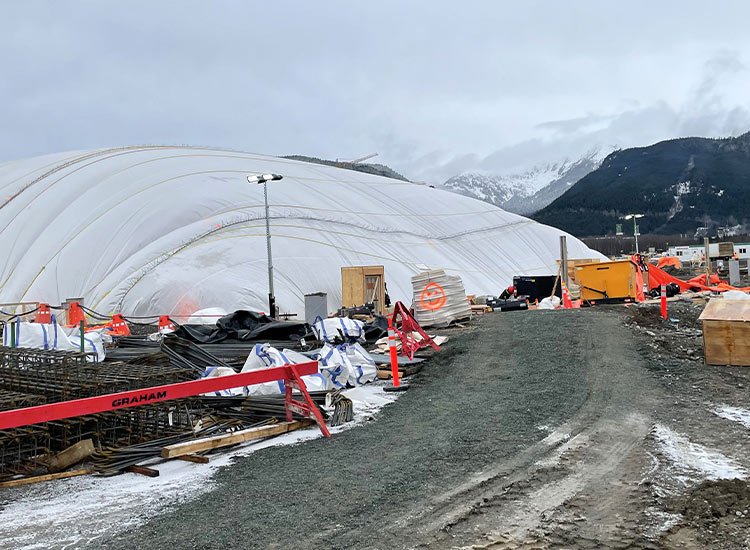Ground Thawing Methods: Which Should You Choose for Your Project?
When winter’s chill sets in, and frozen ground poses a challenge for industrial projects, choosing the right ground-thawing solution is critical. From thermal blankets and hot air blowers to advanced glycol heating systems, there are various methods to keep your operations running smoothly. But how do you determine which option is best for your project?
This guide examines the different methods, outlining their advantages and limitations, with a spotlight on the powerful and efficient glycol heating system.

Thermal Blankets: Great for Small-Scale Projects
Thermal blankets are widely used for ground thawing due to their simplicity and cost-effectiveness. These insulated materials trap heat and direct it toward frozen surfaces, making them ideal for smaller or less intensive projects. However, their limitations become evident when tackling larger, more demanding industrial needs.
Pro #1: Affordable and Reusable
Thermal blankets are a budget-friendly alternative to advanced systems like glycol heaters. Their reusability makes them economical for small projects requiring repeated applications.
Pro #2: Lightweight and Easy to Deploy
Thermal blankets are lightweight and easy to handle. They are simple to transport and position on-site, and their quick setup eliminates the need for heavy machinery.
Pro #3: Ideal for Small-Scale Projects
Thermal blankets are perfect for localized applications like thawing garden soil, pathways, or small construction zones. Their straightforward use makes them accessible even to teams with minimal experience.
Con #1: Limited Heat Intensity
While effective for surface-level thawing, thermal blankets lack the power to penetrate deeply frozen ground. For industrial projects requiring substantial heat transfer, they may not deliver the desired results.
Con #2: Ineffectiveness in Extreme Cold
Thermal blankets struggle to perform in environments with consistently subzero temperatures. Under such conditions, their heat retention capabilities may be insufficient to meet the demands of industrial applications.
Best Use Cases for Thermal Blankets
Thermal blankets are most effective for:
- Smaller-scale projects
- Time-sensitive applications
Hot Air Blowers: Quick-Acting and Portable
Hot air blowers are a popular ground-thawing solution, especially for projects where speed and portability are key priorities. These devices use fans to direct warm air over frozen surfaces, making them effective for surface-level thawing. However, their energy inefficiency and limited depth of impact can pose challenges for larger industrial projects.
Pro #1: Relatively Quick for Surface Thawing
Hot air blowers deliver a steady stream of warm air, rapidly loosening frozen surface layers. This makes them an excellent choice for time-sensitive tasks that require quick ground preparation.
Pro #2: Portable and Easy to Operate
Hot air blowers are lightweight and compact, easy to transport and maneuver on-site. Their simple operation enables teams to deploy them efficiently, even without extensive training or specialized equipment.
Con #1: Inefficient for Large Areas or Deep Frost Layers
Hot air blowers are most effective for localized thawing. Over larger areas, the warm air disperses too quickly, and their performance declines. Additionally, they are less suitable for penetrating deeply frozen ground.
Con #2: Energy-Intensive and Not Environmentally Friendly
These devices consume significant energy, leading to higher operational costs. Their reliance on electricity or fossil fuels results in a larger environmental footprint, making them less ideal for projects with sustainability goals.
Best Use Cases for Hot Air Blowers
Hot air blowers are best suited for:
- Small-scale industrial applications
- Time-sensitive repairs
- Surface preparation
Glycol Heating Systems: A Game-Changer for Industrial Ground Thawing
Glycol heating systems are among the most efficient and reliable solutions for tackling frozen ground in industrial settings. These systems work by circulating heated glycol—a specialized antifreeze liquid—through a network of hoses laid across the frozen surface. This process delivers consistent, high-intensity heat transfer, making glycol systems the top choice for large-scale and deep-thawing projects, even in the harshest winter conditions.
Pro #1: Unparalleled Efficiency
Glycol heating systems easily handle extensive areas and penetrate deep frost layers. They perform reliably in extreme subzero temperatures, ensuring uninterrupted operations in even the coldest environments. This efficiency minimizes project delays caused by frozen ground, keeping timelines on track.
Pro #2: Even Heat Distribution
The continuous circulation of heated glycol ensures uniform thawing across the entire area. This eliminates hot spots and uneven melting, reducing structural risks and safety concerns associated with inconsistent ground conditions.
Pro #3: Eco-Friendly Option
Many glycol systems run on sustainable fuel sources, such as biodiesel or natural gas, significantly lowering their carbon footprint. For companies prioritizing sustainability, glycol heating systems offer an environmentally responsible solution without sacrificing performance.
Pro #4: Versatility
Glycol heating systems are suitable for a variety of industrial applications. Their adaptability makes them an invaluable investment for industries with diverse thawing needs, from construction to pipeline projects.
Con #1: Higher Initial Investment
Glycol heating systems have a higher upfront cost than simpler solutions like thermal blankets or hot air blowers. However, their long-term efficiency and capacity for large-scale projects often justify the expense. For cost-conscious teams, renting glycol heaters from one of our Cahill Heating Rental locations offers a practical alternative, delivering top-tier performance without the full purchase price.
Con #2: Complex Setup
Installing glycol heating systems requires technical expertise and professional oversight. Fortunately, when you rent from our locations, we provide training for your team leaders to operate the systems effectively. Additionally, our in-the-field maintenance and repair services for remote work sites ensure your operations run smoothly and confidently.
Best Use Cases for Glycol Heating Systems
Glycol heating systems are ideal for:
- Large-scale construction projects
- Pipeline installation and repairs
- Heavy industrial applications
- Time-critical projects
Glycol Heater Rentals for Industrial Projects in Alberta
Are you looking for expert advice or assistance with glycol heating systems? Reach out to our Red Deer or Fort McMurray locations today. Discover how this innovative technology can efficiently address your ground-thawing needs and keep your projects on track, even in Alberta’s harsh winter conditions.
